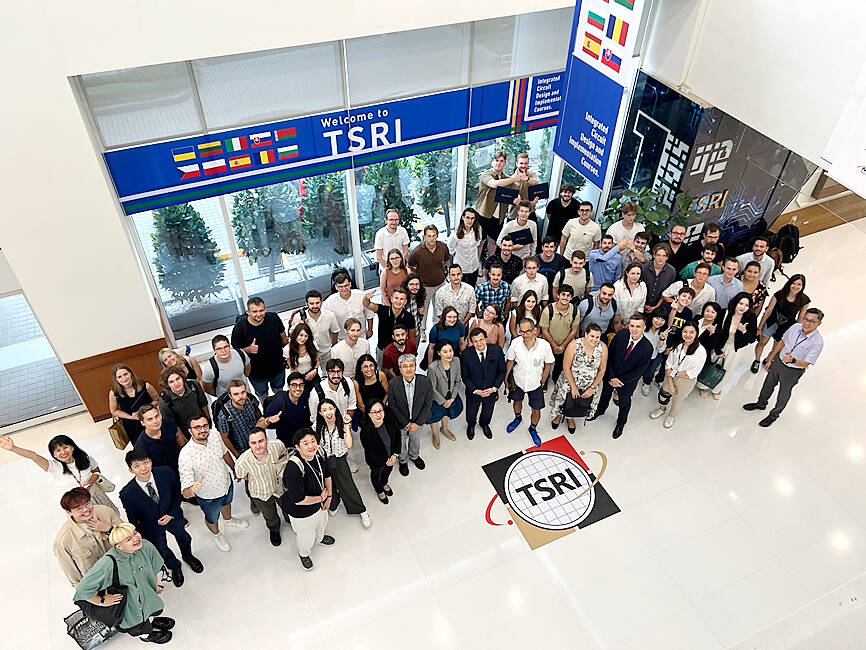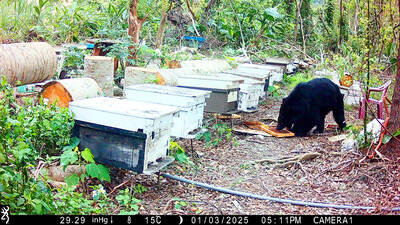The nation’s technology diplomacy over the past few years has seen more than 100 cooperative agreements or memorandums of understanding (MOU) signed with more than 20 countries.
The international community became aware of the significance of Taiwan and the semiconductor sector after the COVID-19 pandemic, which spurred international exchanges in science and technology at the national level, National Applied Research Laboratories (NARLabs) International Affairs Office director Chang Mei-yu (張美瑜) said.
While European countries focus on semiconductors, biomedicine, high performance computing, artificial intelligence (AI) and marine technology, the US was more interested in semiconductors, biomedicine, information and communications technology (ICT), and smart cities, she said on Saturday.

Photo courtesy of the National Applied Research Laboratories
In Asia, collaborations on AI, ocean technology and disaster prevention were initiated, while cooperative agreements in disaster prevention and ICT were also signed in Oceania, Chang added.
The cooperation has gone beyond academia to the level of government agencies, she said.
For example, the Office of the Chief Scientist of New South Wales, Australia, which signed an agreement on bilateral exchanges in semiconductors and quantum technology with NARLabs, is an agency of the state government, Chang said.
Another agreement signed in 2023 with Germany’s Saxon State Ministry of Science, Culture and Tourism — which was an extension of the Science and Technology Arrangement between Taiwan and Germany — also prioritized semiconductors, she added.
NARLabs also signed an agreement with Mitacs, a nationwide non-profit organization in Canada subsidized by the Canadian government, to conduct talent exchanges, with seven Taiwanese college students selected last year for an internship in Canada, Chang said, adding that the figure would total 30 students this year.
Taiwanese and Canadian students could also apply for exchange internship at laboratories via a bilateral MOU, she said.
Under the Taiwan-Czech Democratic Partners Supply Chain Resilience, NARLabs was commissioned by the Ministry of Foreign Affairs to run the Advanced Chip Design Research Center in the Czech Republic, which entered cooperation last year with local colleges, including the Technical University in Prague, Brno University of Technology and Masaryk University, Chang said.
These Czech universities would put forward their curricular plans, and some classes would be supported by Taiwanese teachers, with courses ranging from AI, semiconductor chips for cars, materials technology, cybersecurity and biomedicine, she said, adding that there would also be Czech students visiting Taiwan for internships via the cooperation.
In other scientific research exchanges, the National Science and Technology Council has installed Taiwan-made smart disaster prevention systems at 114 stations across 10 countries under its New Southbound Policy over the past few years.
The council’s National Science and Technology Center for Disaster Reduction has been exporting Taiwanese smart disaster prevention technologies, such as seismic wave detecting and precipitation monitoring systems, to New Southbound Policy countries since 2018, the center’s director Hongey Chen (陳宏宇) said.
The program was initiated by former minister of science and technology Chen Liang-gee (陳良基), with the first MOUs signed with the Philippines’ Iloilo City, he said.
Other New Southbound Policy countries, including Bhutan, Nepal, India, Vietnam, Palau, Thailand, Indonesia and Malaysia have also signed MOUs with the council, Chen said, adding that the United Arab Emirates also joined the cooperation.
As of last month, the council had signed 14 contracts with 10 countries and helped install smart disaster prevention systems at 114 stations, he said.
The earthquake detection system, P-Alert, was developed by a research team led by Wu Yih-min (吳逸民), a professor in the Department of Geosciences at National Taiwan University, he said.
It is a Taiwan-made on-site P-wave earthquake warning device that can produce early warning earthquake reports and record their intensity in real-time, he said.
The precipitation monitoring system can yield instant precipitation data, which are especially useful during rainy seasons or typhoons to help evacuate people to safe areas, Chen said.
Such smart disaster prevention systems can also assist in constructing a disaster information network tailor-made to local regions to compile data for disaster impact evaluation, he added.

SHIPS, TRAINS AND AUTOMOBILES: The ministry has announced changes to varied transportation industries taking effect soon, with a number of effects for passengers Beginning next month, the post office is canceling signature upon delivery and written inquiry services for international registered small packets in accordance with the new policy of the Universal Postal Union, the Ministry of Transportation and Communications said yesterday. The new policy does not apply to packets that are to be delivered to China, the ministry said. Senders of international registered small packets would receive a NT$10 rebate on postage if the packets are sent from Jan. 1 to March 31, it added. The ministry said that three other policies are also scheduled to take effect next month. International cruise ship operators

NUMBERS IMBALANCE: More than 4 million Taiwanese have visited China this year, while only about half a million Chinese have visited here Beijing has yet to respond to Taiwan’s requests for negotiation over matters related to the recovery of cross-strait tourism, the Tourism Administration said yesterday. Taiwan’s tourism authority issued the statement after Chinese-language daily the China Times reported yesterday that the government’s policy of banning group tours to China does not stop Taiwanese from visiting the country. As of October, more than 4.2 million had traveled to China this year, exceeding last year. Beijing estimated the number of Taiwanese tourists in China could reach 4.5 million this year. By contrast, only 500,000 Chinese tourists are expected in Taiwan, the report said. The report

The Forestry and Nature Conservation Agency yesterday launched a gift box to market honey “certified by a Formosan black bear” in appreciation of a beekeeper’s amicable interaction with a honey-thieving bear. Beekeeper Chih Ming-chen (池明鎮) in January inspected his bee farm in Hualien County’s Jhuosi Township (卓溪) and found that more than 20 beehives had been destroyed and many hives were eaten, with bear droppings and paw prints near the destroyed hives, the agency said. Chih returned to the farm to move the remaining beehives away that evening when he encountered a Formosan black bear only 20m away, the agency said. The bear

HORROR STORIES: One victim recounted not realizing they had been stabbed and seeing people bleeding, while another recalled breaking down in tears after fleeing A man on Friday died after he tried to fight the knife-wielding suspect who went on a stabbing spree near two of Taipei’s busiest metro stations, Taipei Mayor Chiang Wan-an (蔣萬安) said. The 57-year-old man, identified by his family name, Yu (余), encountered the suspect at Exit M7 of Taipei Main Station and immediately tried to stop him, but was fatally wounded and later died, Chiang said, calling the incident “heartbreaking.” Yu’s family would receive at least NT$5 million (US$158,584) in compensation through the Taipei Rapid Transit Corp’s (TRTC) insurance coverage, he said after convening an emergency security response meeting yesterday morning. National